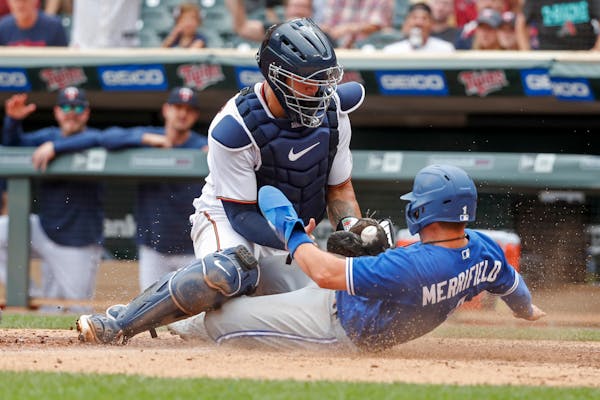It hadn't been a good inning for Dylan Bundy on Saturday night, having given up Bo Bichette's two-run homer to tie the score 2-2. But after inducing a Danny Jansen fly out to end the fourth, Bundy reached the Twins dugout and began thinking about the fifth.
Then he saw Rocco Baldelli walking toward him.
"There's never a discussion. I know as soon as he comes over, it's game over," Bundy said, shrugging. "Shake his hand, look him in the eye, and evaluate from there."
Bundy's initial self-evaluation was disappointment, he said, at such an early, abrupt end to his evening against the Blue Jays.
"Obviously, I want to go deep in the game. Five innings is like the minimum as a starting pitcher. Didn't quite make it there tonight," the 29-year-old righthander said. "Wasn't too efficient, so it led to to the top of [Toronto's] order coming up in the fifth. [Avoiding them] is kind of how we're running things, and I understand that."
Most baseball observers, and surely most Twins fans, understand it by now, too. Baldelli insists it's not a blanket policy; it's more of a nightly choice that has tended to come down one way lately. Regardless of the process, though, the result has been clear: No team tries to avoid the so-called "third-time-through penalty" more than the Twins.
"We make all of our decisions on a game-by-game and really, at-bat-by-at-bat basis. We're just trying to win the game that we're playing," Baldelli said. "Sometimes it's letting your guy go out there and throw 98 pitches and do it that way. Sometimes, it's having your starters go four innings."
The Twins have leaned heavily toward the latter scenario, particularly this season — and it's an understandable choice. No team has paid a higher third-time-through penalty — the statistical fact that hitters tend to be more productive the more times they face a pitcher in a game — than the Twins.
“Our guys are thrower harder, and secondary pitches are nastier than ever before. But very few guys can do that for eight innings.”
Though Baldelli and his quick hook have limited such matchups to only 293 plate appearances in this season's 108 games so far, easily the fewest in the major leagues, no team's starting pitchers have been more ravaged by opposing hitters in those situations.
Devin Smeltzer, for instance, has given up six home runs to hitters facing him a third time, in only 43 at-bats. Bundy has given up only one homer, but seven doubles in 54 at-bats. For all of Joe Ryan's success this season, he has given up 10 extra-base hits, plus eight singles and four walks, in only 66 plate appearances. As a team, Twins starters allow a .316 batting average, a .358 on-base percentage and a whopping .568 slugging percentage — every hitter becomes Mike Trout, in other words — the third time through an opposing batting order.
"There are very few [pitchers] that get stronger as the game goes on. You look at third-time-through, those numbers are pretty clear," said Twins bench coach Jayce Tingler, who made pitching-usage decisions as Padres manager for two seasons. "There's no mystery why starters' innings are declining. Each game, they're all individual and different, but you're always trying to make decisions that will help you win games. A lot of guys, two times through is kind of a sweet spot for them."
It's a sport-wide trend, of course, and the Twins reflect it more than most. The eight full seasons with the fewest innings pitched by Twins starters all have occurred in the past decade, and the Twins' current pace — their pitchers average 4.83 innings per start, second-lowest in the majors — projects to a 782-inning season, breaking last year's all-time Twins low of 795⅔. Only six times have Twins starters completed seven innings, fewest in the AL.
Pitches per start, same story: Twins starters have thrown 80 pitches 48 times, fewest in the majors and less than half the 98 such starts the Astros and Padres have recorded. But the numbers are at historic lows all over the game.
It's not because pitchers are less athletic or talented, Tingler emphasized; the opposite is true, actually. The average big-league pitcher, he said, is expected to throw far harder than ever before.
"Respectfully, guys can't throw eight innings at 87-88 miles per hour and try to hit spots. That's not going to work anymore. That's not today's game," Tingler said. "It's not just baseball. Look at the NFL — Pat Mahomes is running this way and then throwing 70 yards that way. Watch golf — guys are hitting it distances they've never hit before. In basketball, centers have point-guard skills now.
"Our guys are thrower harder, and secondary pitches are nastier than ever before. But very few guys can do that for eight innings."







